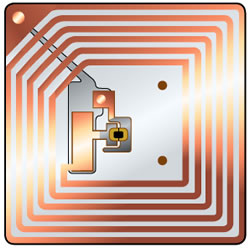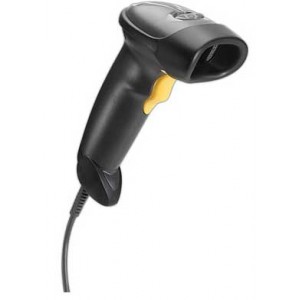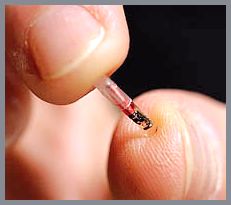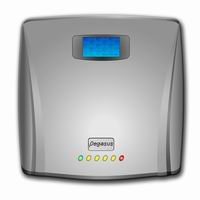RFID stands for radio-frequency identification and is the technology, which much similar to the barcode technology allows information to be exchanged between labels and readers. However, unlike the barcodes, this technology uses radio waves, which bring in a number of advantages and even though the barcodes have seen their fair share of evolvement and the latest symbologies offer much better reliability, readability, and can store more data, they have been around for more than forty years, and RFID is their most likely replacement.
 The smart labels, which use radio-frequency identification technology can communicate within a network and allow users to track every product not only on the shelves, but when in transit. This could and will be used in almost every environment where inventory is tracked, but the retail stores, distribution centers, mailrooms, transport companies, and light industrial environments are likely to benefit the most of it. In the retail stores and supermarkets, using RFID tags could put almost an immediate stop to the long lines. Instead of waiting for an employee to use a barcode reader on each of the items that you have placed in your shopping trolley or basket, RFID readers could automatically read the products’ information, calculate the total before you reach the checkpoint, and deduct the money directly from your bank account or credit card. This would allow you to simply get into any retail store, select the products that you want to purchase, put them in your basket, and get out without having to wait in line. Curiously enough, the smart RFID tags were once mainly used to track cattle, but today are used to trail products, airline passengers, vehicles, and even pets.
The smart labels, which use radio-frequency identification technology can communicate within a network and allow users to track every product not only on the shelves, but when in transit. This could and will be used in almost every environment where inventory is tracked, but the retail stores, distribution centers, mailrooms, transport companies, and light industrial environments are likely to benefit the most of it. In the retail stores and supermarkets, using RFID tags could put almost an immediate stop to the long lines. Instead of waiting for an employee to use a barcode reader on each of the items that you have placed in your shopping trolley or basket, RFID readers could automatically read the products’ information, calculate the total before you reach the checkpoint, and deduct the money directly from your bank account or credit card. This would allow you to simply get into any retail store, select the products that you want to purchase, put them in your basket, and get out without having to wait in line. Curiously enough, the smart RFID tags were once mainly used to track cattle, but today are used to trail products, airline passengers, vehicles, and even pets.
How did it all start? The idea originated from a number of companies, which were looking at the possibilities of constantly monitoring their assets with the use of radio frequency identification. They have enlisted the help of researchers from the MIT (Massachusetts Institute of Technology) and formed an Auto-Id center; the gist of this idea was to develop a technology, which would use a number of devices, spread throughout an enterprise, which devices would communicate constantly with each other and keep track of all assets, their destination, condition, and contents.
 Compared to the USB bar codes, the RFID tags not only store data more efficiently, but they have reading and writing capabilities, which allows the data to be stored, updated or locked. The RFID tags can also be read from a greater distance than the barcodes, their readers do not require direct line of sight (the barcode readers do), and can read the data much faster. The smart tags, which use this technology are also far more rugged and can be reused numerous times since they can be embedded within the product and do not have to be placed on the outside like the barcodes. Their only disadvantage is the higher cost, which explains the fact that they were initially used to track only large items, however, the newest technology developments are likely to soon make their large-scale use possible.
Compared to the USB bar codes, the RFID tags not only store data more efficiently, but they have reading and writing capabilities, which allows the data to be stored, updated or locked. The RFID tags can also be read from a greater distance than the barcodes, their readers do not require direct line of sight (the barcode readers do), and can read the data much faster. The smart tags, which use this technology are also far more rugged and can be reused numerous times since they can be embedded within the product and do not have to be placed on the outside like the barcodes. Their only disadvantage is the higher cost, which explains the fact that they were initially used to track only large items, however, the newest technology developments are likely to soon make their large-scale use possible.
How does RFID work?
 In order for the radio-frequency identification system to work, a number of elements are needed: a reader with a decoder, which interprets the data, RDIF tag (transporter), and scanning antenna. The reader sends out a radio frequency signal, which communicates with the tag, and then its receiver captures the reply signal and decodes it. The tags, which are used today, are either passive or active, where the former do not have power source on their own, while the latter are typically powered by batteries. The advantages of the passive tags is that they can be used for a long time (possibly for decades), but they can hold less data and are readable from relatively short distance (normally ten feet or less). On the other hand, the active tags can be read from as far as 300 feet, require less intense signal from the reader, and can contain data loggers and sensors. Since they have their own power source, these tags can hold time-sensitive data, have significant memory, and are far more suitable for applications, where collection of tags needs to be read simultaneously. It should be noted that despite its name, a RFID reader can actually write data to the tags as well, and even though the passive tags have their shortcomings, their low cost is likely to help popularize the use of this technology.
In order for the radio-frequency identification system to work, a number of elements are needed: a reader with a decoder, which interprets the data, RDIF tag (transporter), and scanning antenna. The reader sends out a radio frequency signal, which communicates with the tag, and then its receiver captures the reply signal and decodes it. The tags, which are used today, are either passive or active, where the former do not have power source on their own, while the latter are typically powered by batteries. The advantages of the passive tags is that they can be used for a long time (possibly for decades), but they can hold less data and are readable from relatively short distance (normally ten feet or less). On the other hand, the active tags can be read from as far as 300 feet, require less intense signal from the reader, and can contain data loggers and sensors. Since they have their own power source, these tags can hold time-sensitive data, have significant memory, and are far more suitable for applications, where collection of tags needs to be read simultaneously. It should be noted that despite its name, a RFID reader can actually write data to the tags as well, and even though the passive tags have their shortcomings, their low cost is likely to help popularize the use of this technology.
 The latest on the RFID technology – much like the barcode readers have evolved and the latest laser scanners are handheld and capable of running hundreds of scans per minute, the RFID readers have evolved as well. The latest models are also handheld, giving an employee the freedom to roam through a warehouse or a large department store and read tags on hundreds of items. Using wireless technology, they can transmit data to handheld devices or computer, and their processing power has been growing as well. Another important development is the international standardization, a process, which although not completed, has started and is likely to give the use of RFID tags and readers a boost. The European Article Numbering and the Uniform Code Council have formed a new body, EAN.UCC, which serves as an umbrella over a number of sub-organizations, where EPCglobal is the one that is trying to develop a system of standard identification electronic codes. So far, only the most basic RFID tag, the Class 0 tag, has been defined, but this class tags use the currently 64-bit internationally recognized EPC (electronic product code). The future of the RFID technology depends largely on the price of the used tags, and while the active tags are still costly and have found use only in certain applications the price of the passive tags has been steadily declining and is expected to fall even further as new production technologies are developed. The latest RFID tags are superior to their predecessors, can hold more data, and are able to communicate with the readers from a larger distance, which would inevitably increase their usage in the marketplace.
The latest on the RFID technology – much like the barcode readers have evolved and the latest laser scanners are handheld and capable of running hundreds of scans per minute, the RFID readers have evolved as well. The latest models are also handheld, giving an employee the freedom to roam through a warehouse or a large department store and read tags on hundreds of items. Using wireless technology, they can transmit data to handheld devices or computer, and their processing power has been growing as well. Another important development is the international standardization, a process, which although not completed, has started and is likely to give the use of RFID tags and readers a boost. The European Article Numbering and the Uniform Code Council have formed a new body, EAN.UCC, which serves as an umbrella over a number of sub-organizations, where EPCglobal is the one that is trying to develop a system of standard identification electronic codes. So far, only the most basic RFID tag, the Class 0 tag, has been defined, but this class tags use the currently 64-bit internationally recognized EPC (electronic product code). The future of the RFID technology depends largely on the price of the used tags, and while the active tags are still costly and have found use only in certain applications the price of the passive tags has been steadily declining and is expected to fall even further as new production technologies are developed. The latest RFID tags are superior to their predecessors, can hold more data, and are able to communicate with the readers from a larger distance, which would inevitably increase their usage in the marketplace.
